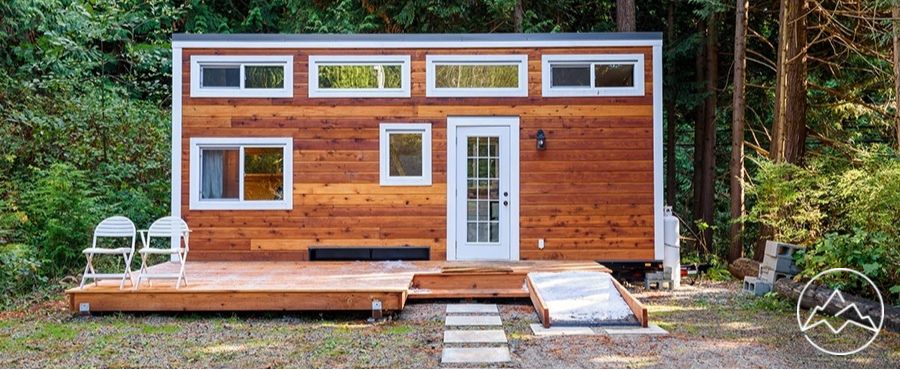Tiny house living has become a bonafide phenomenon over recent years, with more and more people making the transition to a simpler, more condensed form of living. Living tiny certainly presents its challenges, yet there are tons of ideas to smooth the process. In this article, we bring you 3 cool RV/Tiny House projects that you can undertake to make your small living space just right for you.
Tiny House vs RV
Many people are confused about the difference between a tiny house and an RV. Here’s a quick tiny house vs RV comparison to highlight those differences:
| Tiny House | R.V. |
| Heavy frame
Eco-friendly, recycled and sustainable Around 14 feet high by 9 feet in width Very customizable Year-round living Heavy and hard to tow | Lightweight frame
Mass-produced Smaller than a tiny house Not customizable Travel trip living Lightweight and easy to tow |
Tiny House Project #1: Pull down laundry drying rack
What you’ll need:
- 2 x 2’ precut birch (1/2 inch thick)
- Two 1/2 x 2” poplar boards
- Two 3/8” dowel rods (48” long)
- Sash lock
- Narrow loose pin hinges (set of two)
- D ring hangers for mounting on the wall
- Bracketed hinge for side (or chain with small screw eyes)
- Three white porcelain knobs
- Primer and paint of choice
Tools required: Drill bit set, including 3/8 inch drill bit, screwdriver, framing nails, a hammer, and a saw.
How to do it:
- Measure and cut your 1/2 inch x 2 boards to fit the 2 x 2 precut birch. Cut your dowel rods to fit inside your drying rack frame.
- With your 3/8 inch drill bit, drill holes for your precut dowel rods. Use a mallet to hammer dowel rods into predrilled spots.
- Finish assembling your rack with framing nails.
- Attach your pin hinges with a screwdriver.
- Prime your wood drying rack, then paint with your color of choice.
(This project was created by Kate Riley).
Tiny House Project #2: Slide out pantry
What you need:
- (1) 24″ x 48″ x 0.75″ wood board
- (1) 5″ x 8′ x 0.5″ wood boards
- (6) 24″ x 4″ x 0.5″ wood boards
- (1) 24″ x 4″ x 0.75″ wood board for the base
- (1) handle with attaching hardware
- (2) 3″ caster wheels
- (6) 25″ x 0.25″ wooden dowels
- (7) wood glue
- (8) wood screws
- Tools Required: Electric saw, hot glue gun, screwdriver
How to do it:
- Frame the pantry by cutting the 5″ x 8′ x 0.5″ board in half to create two equal 4-foot pieces. These two 4 foot pieces are the sides of the pantry. For the bottom shelf, use the 24″ x 4″ x 0.75″ piece. For the top shelf, use one of the 24″ x 4″ x 0.5″ pieces. Once all the wood for the pantry is cut, glue and join them with screws.
- Space the remaining five 24″ x 4″ x 0.5″ wood pieces, out as follows (from top to bottom):
4.5″, 6.5″, 7.5″, 9.25″, 11.25″
Now drill the holes for the wood dowels to slide through for each shelf, and cut the wood dowels to 25.5″. - Add the wheels by locating the center of the bottom board and space the wheels out evenly on the board. Use a hot glue gun to attach the wheels to the board.
- The final step is the add the handles. Stand your new pantry up on its wheels and work out where the handles should go in accordance with your height. Now locate the center of the side panel and drill two holes to align with the handle. Use the attaching hardware to attach the handles.
Tiny House Project #3: Clothes rack chain
What you need:
- Approx, 1 foot of chain
- S-hook
- Spray Paint
How to do it:
- Spray paint your chain and S hook and allow them to dry.
- Hang the chain on the small end of the S hook. Hook the large end of the S hook onto your closet rod.
- Place hangers into every chain link and begin hanging your clothes.
Tiny House Project #4: Shoe peg organizer
What you need:
- Shaker Pegs, which can be purchased very cheaply from a woodcraft store. You will need 20 of them to store 10 pairs of shoes.
- MDF Board
- Gorilla Glue
Tools Required: 1/2 inch drill bit and drill, Level, Stud finder
How to do it:
- Begin by sanding back the pegs and board. Then prime and paint the board in your chosen color.
- Space the pegs four inches apart with the pegs spaced down the center of the board. Now draw a line down the center of the board and mark where you need to drill the peg holes. Indent the center of each hole with a nail to get a start on the hole.
- Drill the holes at a slight upward angle so that the pegs will tip up slightly. Use a stop block or depth gauge to make sure that the hole depth is accurate.
- You are now ready to attach the board to the wall. Locate and mark the studs using your stud finder. Then screw the board onto the wall at the appropriate height on one side. Place a level on the top of the board to ensure that it is straight and then screw in the other side.
- Now glue the pegs into the holes. Make sure that the pegs fit snugly. Once the glue has dried, clean off any excess.
FAQs About RV/Tiny House Projects
What considerations should be taken into account when planning an RV/Tiny House project?
What are the benefits and drawbacks of using either an RV or a Tiny House for such a project?
How much does it typically cost to construct an RV/Tiny House project?
Are there any legal restrictions or zoning laws that need to be considered before starting such a project?
Are there any tips that can help make the process of constructing an RV/Tiny House easier and more efficient?
Wrapping up
Tiny house living challenges you to be as creative as possible in order to maximize the small amount of living space available. I hope that these four simple projects have inspired you to unleash your own creativity in order to come up with your own tiny living projects.



